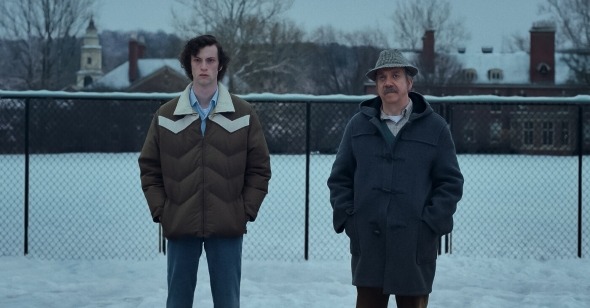Together Again
By Dan Schindel
The Holdovers
Dir. Alexander Payne, U.S., Focus Features
Alexander Payne’s greatest strength as a storyteller has long been his ability to balance abrasiveness and earnestness in ways that have held sometimes-surprising mainstream appeal. Not just anyone could upend the domestic wine market with an independent film. Over time, though, his works have bent increasingly toward sentimentality. In The Descendants (2011) and Nebraska (2013), friction even between the least-likable characters tends to just set them up for tidy emotional conclusions. Downsizing, delving into heady sci-fi concepts and a broader satirical scope, felt like more of a risk, but its resounding flop, breaking Payne’s string of hits, may have been chastening. The Holdovers feels less like a return to form than a retreat to safety. Its initial pretenses of unpleasantness mostly feel like winks at the audience; there’s no doubt that by the end, the disparate lonely characters will come to an understanding and warm some hearts along the way.
Nevertheless, Payne shepherds the plot through these predictable motions with a measure of grace. It helps that the film starts from an inherently affecting premise: the near-elemental desolation of being alone during the holidays. Paul Giamatti plays Paul Hunham, a solitary, universally disliked history professor at Barton Academy, a boys’ boarding school near Boston. As punishment for not giving a legacy student a passing grade, he’s put in charge of minding the kids who can’t go home during the 1970–71 holiday break. Helping him is cook Mary (Da’Vine Joy Randolph), bereaved after the recent death of her son, a Barton graduate, in Vietnam. There are initially five lads under their care, but the story quickly contrives to remove all but one from the school: the intelligent but rebellious Angus (Dominic Sessa). The ensemble film thus becomes mostly a three-hander for the rest of its running time, as Paul, Mary, and Angus let down their guards.
That triangle is lopsided, however. The movie is really about Paul and Angus. They are clearly and repeatedly positioned in parallel, with matching sardonically antisocial temperaments and similarly hostile home lives in their backstories. Paul stands as a possible dark future for the young man if he retreats further into insularity. (Certain death in Vietnam is another potential fate, dangling over him if he gets expelled yet again from school.) But David Hemingson’s script doesn’t fully factor Mary into its interpersonal equations. She’s absent for long stretches, particularly during the late portion of the film which relocates from Barton to Boston. She’s not an afterthought, but Hemingson and Payne sometimes seem at a loss with how to handle her.
Randolph skillfully maneuvers Mary’s tremendous grief. In a less talkative role than Giamatti or Sessa, she plays at a more subtle register. One moment when she simply retrieves her son’s baby clothes from storage feels more laden with honest emotion than the many scenes in which someone very bluntly explains their life situation and how they feel about it. Too often it’s not that the film lets Mary leave things unsaid, but rather that it doesn’t have space for her, forgoing any of her personal revelations while the movie focuses on its true protagonists.
Tipping its attention toward its white characters, the film has a curiously sanitized conception of race relations. Save one mild early incident of bullying, 1970s Boston somehow is devoid of racism. That kind of willful colorblindness is one of many contemporary signifiers in a film that otherwise doggedly tries to recreate the look and feel of a ’70s picture, complete with fake film grain and scratches on the images. There are even a period-appropriate MPAA warning and a cutesy throwback production logo for Focus Features at the beginning. In some respects, the facsimile is impressive. The production design is astonishingly accomplished, as granular in detail across a healthy number of locations as the likes of Once Upon a Time in Hollywood, and assembled on a much lower budget. The emphasis on medium and wide shots, as well as the unhurried, dissolve-heavy editing also convincingly posit a movie that could have been made during the period depicted.
Often, however, the dialogue, acting style, and story progression all clash with this attempted effect. When a girl calls Angus out for looking down her shirt, he delivers a thoroughly modern fumbling “No… yes” response. (A ’70s movie teen would either cockily press forward or come up with a marvelously excruciating deflection.) Hal Ashby is an obvious and cited influence on the filmmakers, but his films, particularly 1973’s The Last Detail, never tried to tie themselves together so neatly. That 50-year-old film perhaps demonstrates the difference in artistic output between people with the realized experience of life during the Vietnam War versus today.Working at such a distance, that war can simply be a threat for one character and an easy explanation of pain for another. The Holdovers is a story about characters slumping their way toward their inexorable fates. They can easily forge empathy for one another, but that won’t on its own help anyone off their life’s path.
That friction between form and spirit makes The Holdovers a curious experience. One wonders if the period setting is even necessary. It originated as script for a TV pilot set at an ’80s boarding school, which Hemingson modified at Payne’s request to loosely adapt Marcel Pagnol’s 1935 picture Merlusse, now in the ’70s. But Payne’s excavation, too constrained by presentism, yields few insights about the past. The film reassures the viewer with resolutions so neat as to feel emotionally forced; the result is an odd, discordantly cuddly film about loneliness and holiday melancholy.
